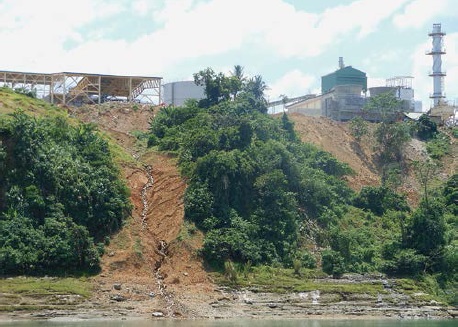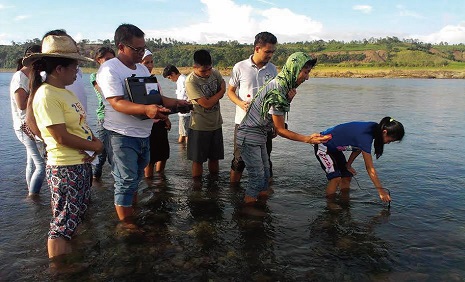Community-based monitoring and grassroots education on the environmental, health, and social impacts of the Isabela Bioethanol and Cogeneration Plant in San Mariano, Isabela.
 |
AGHAM- Advocates of Science and technology for the People Inc. | |
 |
Maria Finesa Cosico | |
 |
JPY 500,000 |
Research Background Final Report (abstract) Others

At the back of San Mariano Biofuel Plant
is the Pinacanauan River that catches
the byproducts of the plant that overflow
from the artificial tailings pond

simulation workshop using the actual
multi-parameter water quality meter
at Pinacanauan River, Brgy. Mallabo,
San Mariano, Isabela Province
Research Background
The operation of Isabela Bioethanol and Cogeneration Plant (IBCP), currently the biggest of the four bioethanol plants in the Philippines, has stirred up complaints from residents of nearby residents. Reports include foul odor, ash fall emitted by the plant and the dumping of organic wastes declared by the company as "liquid fertilizer". The residents also suspect that the IBCP caused the series of fish kills that occurred in a nearby fishing ground.
These complaints were raised to the local government units and the company's administration. However, no concrete action has been initiated by the two. The Philippine government and the company were not responsive to the environmental impacts of the bioethanol operation. While the residents are eager to know and understand these effects, they are unfortunately ill-equipped.
This project aims to enhance environmental awareness of the local community and to build their capacity to monitor and understand the environmental effects of biofuel operation. The research shall consist of four phases (1) organizational building and development, (2) environmental education and awareness (3) community-based environmental monitoring and scientific analysis and (4) grassroots education. The research shall be executed within a total of five (months).
The project will serve as a tool to empower the local community to respond to the environmental pollution contributed by the biofuel plant through scientific data gathering and analysis. The knowledge that they will acquire will be adapted by the community to raise their environmental consciousness and their active participation to engage the company, the local and national government with regard to the environmental impact of the biofuel plant operation.
[Dec. 2014]
Final Report (abstract)
Environmental Education Training
October 24-25, 2015 AGHAM team conducted the training and workshop at Brgy. Hall of Mallabo attended by youth and kagawad (barangay council members) as participants. The activity was conducted to raise their environmental awareness through basic and intermediate scientific concepts related to their local situatuion so that it will be easier for them to put into context the scientific skills that they will be employing for the water quality monitoring program. The program started with introduction of every participant to himself along with expectation check followed by short animated film "Higante't Tutubi" (Giant and dragonfly) as short introduction to main topic on the state of the Philippine environment (SPE). The SPE covers the discussion on the resources, policy, environmental problems due to resource extractive nature of the Philippine economy and how the collective efforts of the people will reverse its drastic effect.
The next day was started with a recap on the previous discussion followed by their sharing on the local situation. AGHAM on its part also shares the result of previous environmental investigation mission conducted in 2014.
Next discussion was about the framework of water cycle, water quality and its importance to their community and to environment. There was also an input on how to operate and use the multi-parameter tester followed by a workshop.
Basic documentation skills was also discussed to teach them how to properly document relevant event in relation to their claims of environmental degredation linked to the plant operation.
Planning for the Sampling
The community identified 3-5 sampling points based on the EIM sampling sites of AGHAM in 2014. For downstream they have identified Benito Soliven (W1), the SWIP (W2), natural lagoon (W3), Pinacanauan river infront of discharge pipe of IBCP (W4) and the upstream of the river at Sentro (W5). The monitoring team should not be less than 4 people for security reasons, it was composed of youth, students and BLGU council members.
Outcome of the Research
Data and Results
-Physical observation
A.Upstream
Water is odorless and clear, however dmestic use of water body (bathing, laundry) was observed onsite. Few aquatic animals were readily observable. Unexpected light rain showers occurred while sampling.
B.SWIP
Water surface was entirely covered with water hyacinths (Eichornia crassipes). Water is dark brown to almost black with foul smell with observable presence of oil. A medium-sized piggery is adjacent to the water body.
C.Impact Area
Water is clear and odorless with numerous aquatic organisms observable.
Result of the Chemical Analysis
The Dissolved Oxygen (DO) of SWIP is very low oxygen level at 0.60 mg/l during the January monitoring that can be attributed to the excessive amount of algae that utilizes oxygen for its own growth, hence the significant drop of DO during the January monitoring. While the Piancanauan River, that is the water body that is located downstream to the biofuel plant and the upstream river system are slightly higher from the DENR standards for water body.
The Electrical Conductvity (EC) for SWIP has been increasing at a staggering rate at 535.33?S/cm compared to the DENR standards during the January monitoring. A highly turbid water indicates pollution. The presence of algae has contributed to the high EC that results to the presence of high organic matter.
The pH of all sampling areas are within the threshold limit set by DENR
A.Other observations
a.Local residents reported that the plant resumed operations at around the end of October 2015. Kgwd. Willy also recalled that after the October 2015 training, police officers went to the community inquiring if the visitors (pertaining to AGHAM) will conduct a rally.
b.The noxious smell from the plant is still prevalent, especially near its location. Residents still complain of respiratory diseases afflicting children and the elderly, which they think is related to the operation of the power plant
Over-all Analysis of the Result
The community-based monitoring of the water bodies that were identified as impact areas of the biofuel plant in San Mariano, Isabela proved the continues deterioration of the water quality specifically in SWIP caused by the unregulated operation of the plant. Respiratory diseases in the community are still prevalent as the operation continues.
Release / Presentation / Publication the outcome of the research
The result of the community-based monitoring report has been presented in the community. This will be used by the residents in their education campaign in the affected areas to solidify the community that will lobby to the government to administer strict regulation with regard to the operation of the plant and demand accountability to the biofuel company for their violations.
Perspective for the continuity of the research
The project will be endorsed to the local farmer and youth organization. The training given to students in Brgy. Mallabo will be essential for their organizing and awareness raising with fellow youth in the village. Barangay LGU hopes to use the results to lobby with the management of IBCP.
[Mar. 2016]
Others
